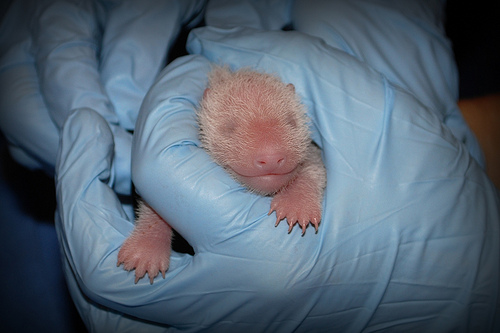Giant Panda Cub at the Smithsonian's National Zoo is Female
Scientists at the Smithsonian Conservation Biology Institute's Center for Conservation and Evolutionary Genetics confirmed that the giant panda cub born Aug. 23 at the National Zoo is female. A paternity analysis showed that the Zoo's panda Tian Tian (t-YEN t-YEN) is the cub's father. Scientists also confirmed the second stillborn cub Mei Xiang (may-SHONG) delivered Aug. 24 was a female, and also sired by Tian Tian. The cubs were fraternal twins.
Zoo scientists used two tests to confirm the sex of both cubs. The first test was developed by scientists in China and analyzes a fragment of the zinc finger protein gene. The second test, also using a shorter fragment of the same zinc finger protein gene, was developed by SCBI scientists and veterinarians. They used the second test to verify the results of the initial test.
For the paternity tests they compared genotype profiles of DNA samples from the cubs to profiles from Mei Xiang, Tian Tian and the San Diego Zoo's giant panda Gao Gao. As a result of previous conservation research, SCBI's Center for Conservation and Evolutionary Genetics had blood samples from Mei Xiang, Tian Tian and Gao Gao on hand. They compared a small sample of muscle tissue from the stillborn cub and a tiny sample of cheek cells from the cub born Aug. 23 to the adult pandas' DNA samples for the tests. Veterinarians obtained the cheek cell sample with a swab during a preliminary health check Aug. 25.
The genetics laboratory conducts conservation research and service for the Zoo and the entire Smithsonian, including sexing animals, determining paternity, and disease testing," said Rob Fleischer, head of the Center for Conservation and Evolutionary Genetics. "This was a great opportunity to assist our reproductive and panda biologist colleagues to assess their artificial insemination methods in pandas."
Mei Xiang was artificially inseminated twice March 30 after natural breeding attempts with the Zoo's male giant panda, Tian Tian, were unsuccessful. A team of Zoo scientists and veterinarians, including Tang Chunxiang, the assistant director and chief veterinarian of the China Conservation and Research Center for the Giant Panda at Wolong, performed the artificial inseminations. During the first procedure she was artificially inseminated with a combination of fresh and frozen semen collected from Tian Tian. The frozen semen was from 2003. The second procedure was performed with frozen semen collected from Tian Tian in 2003 and frozen semen collected from Gao Gao in 2003.
"We had never artificially inseminated Mei Xiang with semen from two males before this past breeding season," said Pierre Comizzoli, reproductive biologist at the Smithsonian Conservation Biology Institute. "If Gao Gao had been the father of one or both cubs, that would have been very interesting because we would have known that the second artificial insemination was the one that was successful."
The David M. Rubenstein Family Giant Panda Habitat has been closed to the public since Aug. 2, and will remain closed until further notice to provide quiet for Mei Xiang and her cub. Both will be visible on the panda cam. Visitors can see Tian Tian in his outdoor habitat and on the panda cam.
Photos are available on the Zoo's Flickr page. Video is available on the Zoo's YouTube page.

